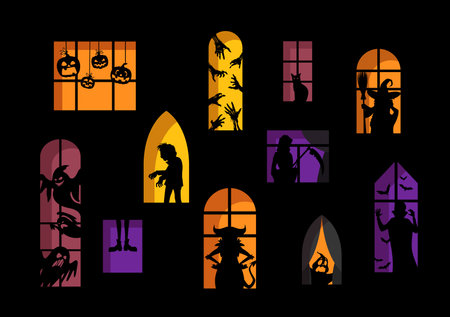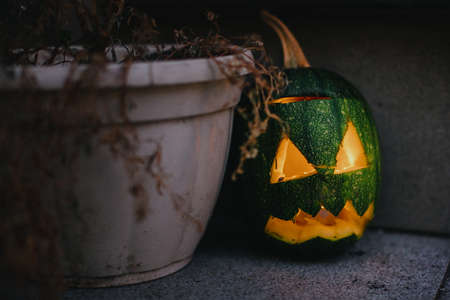The Veil Thins: A Celtic Beginning
As the golden leaves drift through the brisk October air and twilight descends earlier upon the British landscape, a subtle shift occurs—a thinning of the veil that separates our world from the unseen. Long before jack-o’-lanterns flickered in English windows or trick-or-treaters roamed village streets, ancient Celts across Britain observed Samhain, a festival woven with mystery and ancestral reverence. In those mist-shrouded days, Samhain was not merely a seasonal marker but a sacred threshold: a liminal time when the boundaries between the living and the spirit realms blurred like fog over a moor. Elders would gather by firelight, telling tales of ghosts and portents, feeling the pulse of ancient prophecy thrumming beneath their feet. It was believed that on this night, ancestors wandered freely, whispering secrets and warnings to those who listened closely. The customs born from this mystical intersection still echo through modern Halloween celebrations in the UK—where every gust of wind and shadow at dusk might just carry an old soul’s message.
British Ghosts: Spirits in Mist and Memory
Across the rolling hills and ancient stone villages of the UK, Halloween is not just a night for playful frights—it’s a time when the veil between worlds grows thin, and the tales of British ghosts take centre stage. Unlike their Hollywood counterparts, British spectres are woven into the very fabric of local history, appearing in whispered legends by firesides or echoing footsteps along cobbled streets. These spirits linger in the collective memory, threading through generations like mist on a chilly autumn morning.
From haunted country lanes in Yorkshire to the grand yet crumbling manors of Cornwall, each region spins its own spectral yarn. Take for instance the tale of Anne Boleyn’s headless apparition at Blickling Hall or the tragic Lady Grey drifting through Glamis Castle. Their stories are not simply relics; they shape how communities perceive the landscape—imbuing woods and ruins with an otherworldly charge that grows strongest as October wanes.
Iconic Haunts Across Britain
| Location | Ghostly Resident | Local Lore |
|---|---|---|
| Blickling Hall, Norfolk | Anne Boleyn | Headless figure returns home each Halloween night |
| Puckley Village, Kent | The Screaming Man | Crying echoes across the village green after dark |
| Hampton Court Palace, London | Catherine Howard | Screams reverberate down the Haunted Gallery corridor |
| Glamis Castle, Scotland | Ladies in Grey and White | Wandering spirits seen by staff and guests for centuries |
| The Ancient Ram Inn, Gloucestershire | Multiple Entities | Poltergeist activity and shadowy figures said to linger within old timber walls |
The presence of these ghosts is not just about fear—they serve as portents and reminders of ancestral connections. On All Hallows’ Eve, Britons gather to share these tales anew, honouring both the chill of mystery and the warmth of tradition. In this way, each ghost story is more than entertainment; it’s a living thread tying present-day revelers to centuries of wonder, warning, and whispered prophecy.

3. Signs and Portents: Omens in the October Night
As dusk settles over the British Isles and All Hallows’ Eve approaches, the land itself seems to hum with secrets. Generations of folk have looked to the October night for signs and portents—those subtle whispers from the otherworld that warn or guide. In villages from Cornwall to the Scottish Highlands, old wives’ tales still linger, shaping the way we peer into shadowed corners or interpret a sudden chill. Some say that dreams dreamt on Halloween night are prophetic, especially if you sleep with sprigs of yarrow or rosemary under your pillow—a ritual whispered down through centuries as a means to glimpse your future beloved or fate’s next turn.
The superstitions don’t end there. There are tales of spectral black dogs roaming lonely lanes, their appearance an omen of misfortune, while barn owls calling at midnight are said to herald change—or even death. People speak in hushed tones about the “fetch,” a ghostly double seen at twilight, believed to foretell imminent passing or transformation. In certain northern towns, it’s customary to leave bread and salt on doorsteps, offerings to wandering souls seeking solace before winter closes in. These acts are not merely tokens; they are invitations for ancestral wisdom to weave its way into the present, reminding us that on Halloween, the veil is thin and every rustle in the hedgerow might be a message from beyond.
Such beliefs serve as more than cautionary tales; they connect modern Britons with an ancient web of intuition and reverence for the unknown. The October night becomes a living tapestry of symbols—wind swirling leaves across gravestones, distant church bells tolling unexpectedly, a fox’s cry echoing through mist—all read as signs by those attuned to nature’s language. In these moments, Halloween transforms from mere festivity into an opportunity for listening inwardly and outwardly, trusting that every omen has its story, and every story its hidden truth.
4. Ancestor Reverence: Whisperings from the Past
In the cool, mist-laden evenings of late October, the veil between worlds thins—a belief that has echoed through British folklore for centuries. Halloween in the UK is not only about mischievous spirits and spectral tales but also a sacred time to honour those who came before us. The practice of ancestor reverence is deeply woven into the fabric of this season, manifesting in both mystical rituals and everyday acts that continue to resonate in modern life.
Across the British Isles, traditions vary yet share a common thread: a gentle nod to ancestry. In rural villages, families once set an extra place at the table for departed loved ones during Samhain feasts, believing their spirits might visit. In Wales, candles were lit and placed in windows to guide ancestors home. Even today, these gestures persist in subtler forms—lighting a candle, sharing family stories, or preparing favourite foods as offerings.
Traditional Practice |
Modern Echo |
|---|---|
| Setting an extra plate for ancestors at Samhain feast | Lighting a candle for lost loved ones on Halloween night |
| Telling ancestral tales around the hearth | Family gatherings sharing memories and stories |
| Baking soul cakes for wandering spirits | Preparing special treats or baking together as a family ritual |
The Ritual in the Everyday
While some may see these customs as mere folklore, many Britons feel a quiet presence—a sense that their lives are stitched together with threads from generations past. Whether through intentional ceremony or simple daily habits, honouring ancestors during Halloween connects the mystical with the mundane. The act of remembering becomes its own kind of magic, infusing homes with warmth and gratitude.
A Tapestry Unbroken
As bonfires flicker on village greens and children carve pumpkins by lamplight, there remains an unspoken invitation: to listen for the whisperings of those who walked these lands before us. In every ritual—ancient or new—the past is never truly lost; it is carried forward, alive in spirit and story, each Halloween weaving another strand into our shared ancestral tapestry.
5. Modern Mysticism: Contemporary British Halloween
If you wander the lamp-lit streets of Britain on All Hallows’ Eve, you’ll find yourself at the crossroads of old whispers and new wonder. Halloween here is a living ritual, continuously reborn as today’s Britons weave threads of ancient magic with flashes of modern spectacle. Imported traditions—like pumpkin carving and trick-or-treating—have taken root in English gardens, Welsh valleys, and Scottish closes, but they pulse with a distinctly local heartbeat.
It’s not just about costumes and confections; it’s about the subtle sense that something lingers beneath the surface. Children may don witches’ hats and skeleton suits from high-street shops, but in the background hums the wisdom of ancestral stories. In Cornwall, some still light lanterns to guide lost souls, while in Yorkshire, shadowy tales of headless horsemen are revived by torchlight walks across the moors.
The Rituals Reimagined
Contemporary British Halloween is an eclectic tapestry. Parties in city flats might feature tarot readings or Ouija boards alongside apple-bobbing—a nod to fortune-telling games once whispered by firelight in rural kitchens. Community bonfires echo Samhain’s sacred flames, where neighbours gather not just for warmth but for shared remembrance, their laughter mingling with the night wind that carries secrets from centuries past.
Symbols Old and New
Pumpkins, once a North American novelty, now glow beside turnip lanterns—grinning jack-o’-lanterns carved from humble roots that once held sway in Celtic lore. Supermarkets brim with sweets, yet homemade soul cakes still appear in some households, baked to honour those who have crossed the veil. Each symbol is layered with meaning, an invitation to remember—and reimagine—the mysteries that shape our lives.
A Collective Spell
In this twilight blend of imported pageantry and homegrown legend, Britons enact a quiet kind of magic. By blending global customs with echoes of native prophecy, they cast a collective spell: one that honours both the living and the dead, binds communities together, and keeps alive the shimmering possibility that—on this night above all others—the past might gently brush against the present.
6. Story Under Moonlight: Embracing the Mystery
As Halloween night unfurls across the UK, imagine yourself beneath a silvered sky, the moon hanging low and watchful over ancient rooftops and shadowed hedgerows. This is the hour when stories breathe—where the past and the future mingle in the chill air, threading together memory and prophecy. Perhaps you find yourself walking a winding lane in Cornwall, or pausing by an old stone wall in Yorkshire, feeling the hush of spirits and ancestors close at hand. In these moments, every whisper of wind becomes a message, every flicker of candlelight a sign waiting to be read.
Halloween here is more than festive revelry; it is an invitation to listen deeply. The tales our elders once spun—of ghostly coaches on Dartmoor or spectral lights in Scottish glens—are not simply echoes from long ago, but living stories that seek a listener tonight. Close your eyes and recall your own encounters with the mysterious: a fleeting shadow at dusk, an uncanny dream that lingered past morning, or the uncanny feeling that someone unseen walks beside you. These are threads in your personal Halloween tapestry, woven through with both memory and ancestral insight.
This night is also prophecy—a liminal time when ordinary boundaries soften and intuition sharpens. The Celts called it Samhain, when the veil thins and futures may be glimpsed like mist along the Fens. What do you sense stirring within you as midnight approaches? Is there a message awaiting you in the pattern of fallen leaves, or in the rhythm of your heart as you stand alone under the stars?
We invite you to step into this shared story under moonlight. Listen for what wishes to be revealed: perhaps guidance for the months ahead, or reassurance from those who have walked before you. Let your imagination roam freely across fields and forests; let your inner voice rise above October’s hush. In doing so, you honour both tradition and possibility—joining hands with all who have ever wondered at Halloween’s enduring mystery.
Tonight, as lanterns flicker and laughter drifts from distant doorways, remember: you are part of an unbroken line of seekers, dreamers, and storytellers. So trust what comes to you—be it a gentle nudge or a haunting vision—and carry its meaning forward into your own tale. For on this enchanted night in Britain, every soul has a story waiting to be heard beneath the watchful gaze of the moon.


